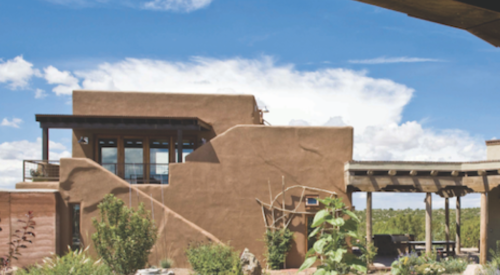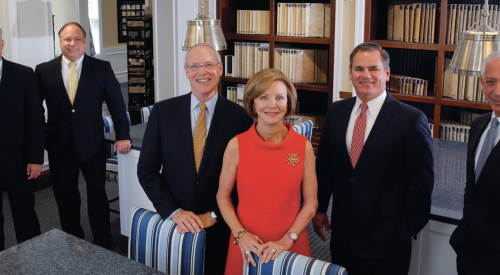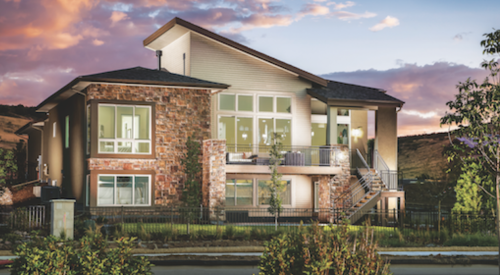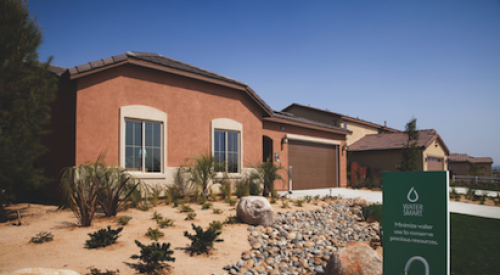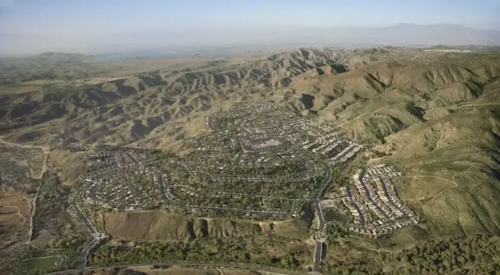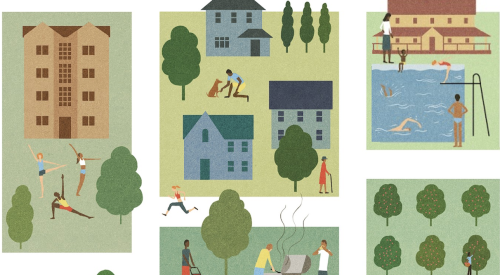| Ken Nakari and John Kurowski at Spirit Gulch, a prototype Built Green Community |
A bellwether state in sustainable housing, Colorado is setting a new standard for green building. The Home Builders Association of Metro Denver, after having created the industry’s first green building checklist for individual homes six years ago, will roll out the first large-scale energy- and resource-efficiency guide for community development this fall.
The new Built Green Communities program will take Colorado’s existing Built Green program for homes several steps further. For a community to qualify, all homes must meet the Built Green Colorado standards, and the community as a whole must attain points in five other categories. Sensitivity in site selection, careful transportation planning, overall planning and design, and natural resource preservation, conservation and restoration will earn developers points on the Built Green Communities checklist.
"Built Green Communities is a comprehensive concept that encourages the developer to think about the total plan in the use of the land," says John Kurowski, chairman of the Built Green Communities task force of the HBA of Metro Denver. For the first time, provisions for open space, traffic control and so forth are part of a green building program, rather than just the houses, Kurowski says.
"Our goal is to have six new communities enter into the program in the first year. That would be an excellent acceptance," Kurowski says. One community, he says, is already close to matching the forthcoming criteria. Spirit Gulch, a high-end development by Sunshine Builders of Denver, is serving as a prototype for Built Green Communities. Greentree Homes, Village Homes and builder Jim Leach are also using the emerging checklist in the planning of new communities in metro Denver and Colorado Springs.
Central to the development of Spirit Gulch is the preservation of natural amenities and planning with respect for the existing landscape. "We took trees, shrubs and other vegetation and transplanted them to our open space," Sunshine vice president Ken Nakari says.
Spirit Gulch also offers public hiking trails that connect to existing trail systems, a feature that Nakari considers a wise use of open space. "[It is] creating community as it’s opening doors to everyone," he says.
Nakari says developing Spirit Gulch as he did cost him 20% to 25% more on infrastructure costs. The roads had to curve, and the homes were built to fit the site rather than forcing the site to fit the homes. But transplanting mature trees and shrubs instead of using a nursery stock resulted in huge cost savings, he says; Sunshine normally pays $50 per foot on trees, and with this project it transplanted 25- to 30-footers.
Nakari hopes Spirit Gulch will help spread the word about building green and says that every community can apply lessons taught by the Built Green Communities guidelines.
"Aesthetically and ethically, this is what should have been done in housing all along," says Nakari. "We need to take full advantage and use all the conservation resources we have available."
Kim Calomino, director of Built Green Colorado and the HBA of Metro Denver, says she sees green building as a definite trend in the home building industry, bolstered by the many groups and guidelines available to builders as resources. She says the NAHB is helping HBAs develop their own green building programs, and they’re coming on board slowly but surely. "We initially thought this was a minor blip on the screen, but now people are more educated about green building," she says.
Built Green Colorado was developed in 1995 by the HBA of Metro Denver; the Governor’s Office of Energy Management and Conservation; Xcel Energy, the state’s largest utility provider; and E-Star Colorado, a provider of home energy ratings. In 2002, the HBA expects that 10,000 homes will have been built to the standards of Built Green Colorado.
Seattle, Atlanta and Kansas City, Mo., are a few of the cities that have modeled their programs after Built Green Colorado, Calomino says. She hopes Built Green Communities will be just as accepted.
